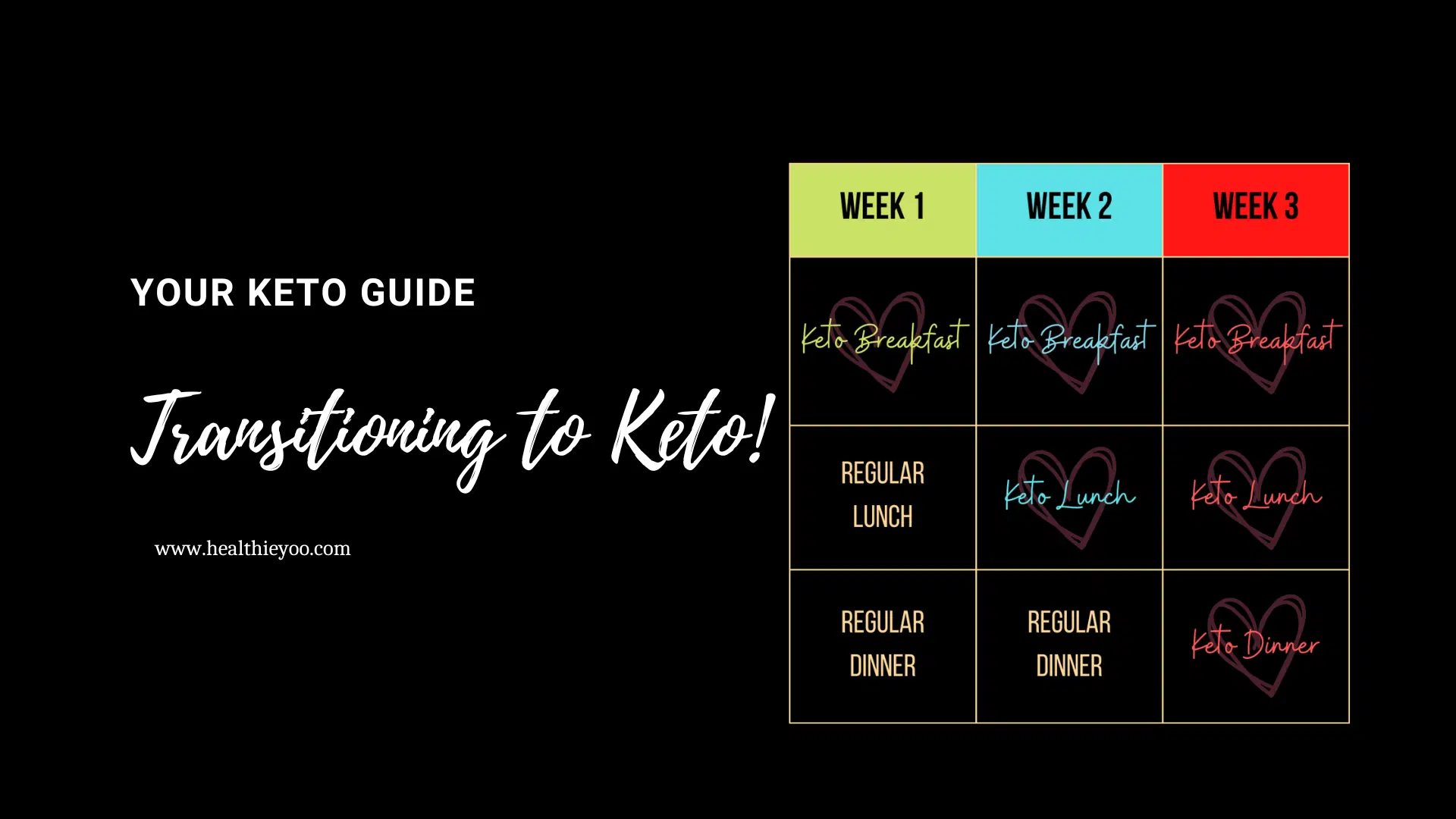Here is a step-by-step guide on transitioning to a ketogenic diet and getting fat-adapted – check out the keto-adaptation tips and tricks for a smooth transition from a high-carb to a low-carb keto diet and how to become fat-adapted.
Rome wasn’t built in a day!
Some people might feel confident jumping right off into the deep end when it comes to making a major dietary change. In fact, a LOT of people try this method the first couple of times they start a new diet (Notice how I said the first couple of times. It’s because this method has a high failure rate). Does this sound familiar?
You’ve cleared all the chips, cookies, and little snack cakes out of your pantry. You’ve gone grocery shopping for everything on the super-healthy meal plan list you downloaded off the internet. You’ve filled your fridge with so many vegetables it doesn’t have space to fit anything else.
Now you’re ready. Tomorrow is DAY ONE. The day your life will change. The day all your dreams of weight loss, better health, more energy, and greater confidence will come true. Tomorrow is the day you’re going to START YOUR NEW DIET.
… And that momentum lasts about a week before LIFE HAPPENS and you get sick, or you take on a new project at work so you’re extra tired and stressed, or there’s a big holiday, or you have to travel… so you run through the drive-through because you’re out of time, or you grab a donut or two for energy in between meetings. By the end of the second week, you still haven’t used up all of those vegetables in your fridge.
What does this mean? Should you give up? Should you try a different diet? Should you maybe rethink your strategy? I vote for that last one.
When trying to get successfully from point A to point B, most people will need to go through several steps in between to achieve their goal. This is especially true when it comes to making major lifestyle changes like dietary ones.
Ketogenic nutrition adds an extra layer of difficulty, in that for it to truly work the way it’s intended, you simply cannot cheat. You can’t fall off the bandwagon unless you want to have to start from the beginning all over again. At least not at first. And then only strategically. (I’ll bet you’ve never heard of strategic cheating, have you?) This makes how you start keto particularly important. It requires careful planning and preparation. But don’t get discouraged! All the best things require a little bit more effort, and there are a number of helpful strategies to help make your chosen path easier and, might I add, even enjoyable.
Allow me to share two of those different methods here:
Slow and steady wins the race!
Three-Week Meal Replacement Strategy
One favorite method to help transition successfully to keto and get fat-adapted is a Three-Week Meal Replacement Strategy.
To do this:
1st Replace regular breakfasts one week with keto breakfasts
2nd Replace regular breakfasts and lunches the next week with keto breakfasts and lunches
3rd Replace all regular meals with keto meals in the third week
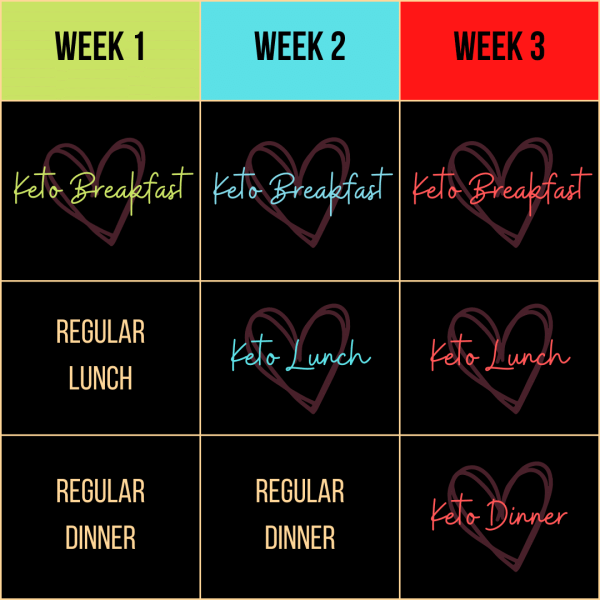
Lower Carb to Keto
Fear of losing momentum is one reason people prefer to hit the ground running rather than choose to make smaller changes over time. As I mentioned before, you might have the motivation to change one week, but that energy is likely to fade in the face of stress, fatigue, and regular schedule interruptions. However, if you can find the patience to go a little more slowly while trying out this next strategy, you might find you like this best in the long run.
If you’d like a name for this one, I call it a type of modified paleo diet.
Paleo is probably closest to a well-formulated keto diet in terms of carbohydrate intake and is similarly nutrient-dense. This modified version allows for a little bit of grain, legumes, and dairy, unlike a stricter paleo plan. It’s perfect for a more gradual carb reduction while introducing nutrient-dense foods that can also be enjoyed on a whole-food ketogenic diet.
To do this:
1st Cut out added sugars
2nd Start baking with keto-friendly ingredients
3rd Adjust your macronutrient ratios:
a) Make sure you’re getting adequate protein
b) Switch your grain/fruit/starch and vegetable portions
c) Add fat to satiety
4th Drop your carbs to keto-level and adjust fat intake
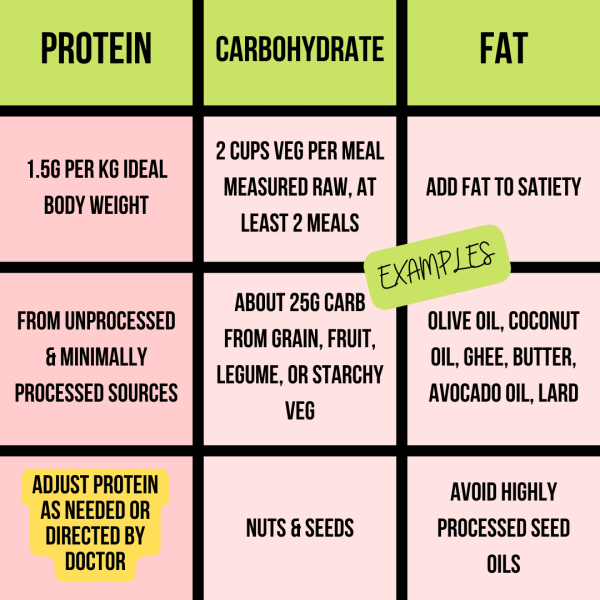
Still, have questions? Let’s break this down a bit more.
Cut out added sugars
Added sugars are anything you add to your food to make it sweeter which will affect your blood glucose. This includes things like sugar, honey, agave, and fruit juice (yep, no more fruit juice).
On a low-carb diet – especially on keto – the only sweeteners you’ll be using will be natural sugar substitutes like stevia, monk fruit, or erythritol among others.
(If you need to pause and use artificial sweeteners on your path from sugar to stevia, then that’s alright. Don’t let not being able to use artificial sweeteners keep you from succeeding. Baby steps lead to bigger ones. And your transition to keto and getting fat-adapted!).
Practice baking with keto-friendly ingredients
Why do I suggest doing this ahead of time? It’s helpful to have a couple of go-to recipes ready to keep you from falling back on old habits if a carb-craving hit while you’re making bigger changes like the transition to keto and getting fat-adapted.
Better to have a slice of keto cake than a slice of high-carb cake in a moment of weakness. If you haven’t practiced, and don’t have anything on hand, then you’re much more likely to grab something quick (and full of carbs) from a grocery store or drive-through.
Here’s a tip: bake a keto treat on the weekend and divide it into seven portions – one for each day of the week.
Try doing an internet search for your favorite dessert. Keto brownies, keto cheesecake, keto lemon pound cake… you’re bound to find something that’s relatively easy to make and that’s much more nutrient-dense and filling than any high-carb alternative. Almond flour, coconut flour, ground flax seed, and eggs are some common ingredients used as staples in ketogenic baking.
Adjust your macronutrient ratios
Do you remember your last trip to an Italian restaurant? You might have enjoyed a plate filled with noodles. Perhaps there was a little beef in tomato sauce on top with a small salad on the side.
Now rethink that visit following a lower carb plan: you’re going to add a bit more protein and FLIP THE RATIO OF NOODLES TO VEGETABLES. If you use this strategy at every meal, you’ll go from eating carb-heavy to eating low-carb in no time.

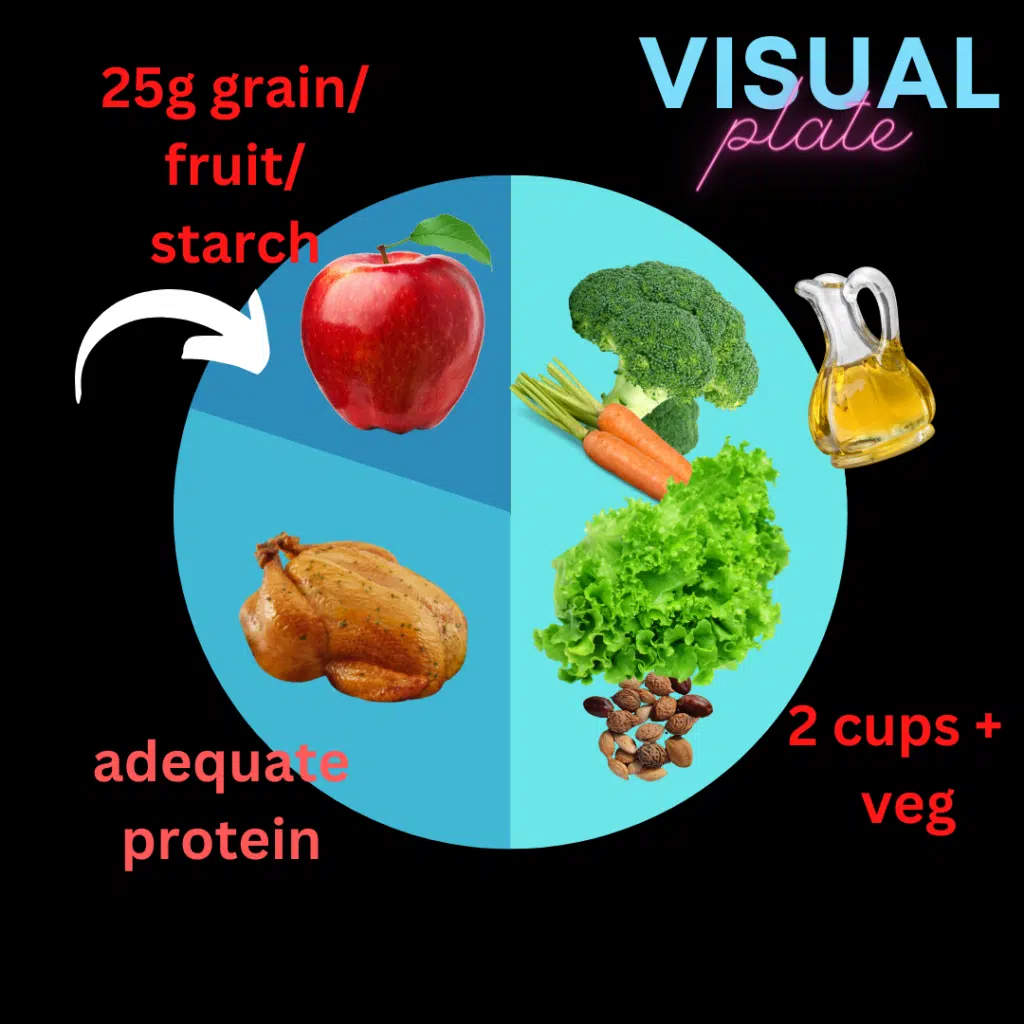
Make sure you get –
1. Adequate protein from unprocessed and minimally processed sources (1.5g per kilogram of ideal body weight is a good place to start, unless your doctor, dietician, or coach recommends something else)
2. 2+ cups of vegetables per meal, measured raw, for at least two meals
3. About 25 net grams of bread, pasta, rice or other grain, starchy vegetable, legumes, or fruit per meal
For example, 25 net grams might look like this:
½ to ¾ cup cooked white or brown rice, pasta, mashed potato, or mashed sweet potato
½ cup dry rolled oats or 1 cup cooked (oatmeal porridge)
1 cup cooked beans (legumes)
1 medium apple or banana
1 medium potato or sweet potato
Why am I including legumes – plant-based sources of protein – in with grains and telling you to limit them as you adopt a lower-carb diet on your way to keto? Simply because most legumes have too many carbs to be included in a well-formulated ketogenic diet.
You can count them towards helping meet your protein goals, but their carbohydrate content will also have to be taken into consideration.
Note: Before you transition fully to keto, be sure, and get that 25 g or so of extra carbs in your meals. When your body is not in a ketogenic state and it’s still using carbs as its main source of fuel, it’s important to get enough carbohydrates to feel good and function properly (if you’re insulin resistant, you might not get enough fuel regardless, but let that be the subject of another discussion).
Add fat to satiety
Once you’ve got the appropriate portion of protein, veg, and extra carb on your plate, add enough fat to keep you full. How much is something you’ll learn as you go along. Basically, if you’re hungry again an hour after you’ve eaten and your hunger is not really thirst or emotionally driven, then you’ll know you need to add a bit more fat to your meals.
Healthy fats can come from fattier foods such as fatty cuts of meat, avocados, nuts, and seeds, as well as butter, ghee, and oils like coconut and extra virgin olive. Avoid heavily processed seed oils like sunflower, canola (rapeseed), corn, and soybean. Nutrient-rich baked goods made from sources such as a nut or seed flour and/or dairy or coconut creams can also add healthy fats to your diet.
Drop your carbs to keto-level and adjust your fat intake
From this type of lower carb, whole food diet, it’s much easier to take the final step and drop those grains, starchy veggies, most legumes, and a good amount of fruit. From here on out, your carbs will come mainly from vegetables, nuts, seeds, and some lower-carb fruits.
If that sounds bland, take a look at some of the many keto meal suggestions and recipes on the internet; there’s no need to feel deprived!
I think I eat much more like a king on keto than I ever did on a high-carb, low-fat diet.
As calories from extra carbohydrates disappear, fat intake will need to be adjusted accordingly.
Using an app to keep track of your protein, carb, and fat intake is crucial for most forms of ketogenic nutrition, if only for the first month or so while you’re getting the hang of things.
Every cloud has a silver lining!
It might seem like too much to ask for someone to move a bit more slowly towards a ketogenic lifestyle rather than going full steam ahead from the get-go, but I especially like to recommend this second method, as it carries with it several advantages.
It can be used to transition not only onto, but also off a well-formulated ketogenic diet, or even as a stand-alone solution. For some people, this type of lower-carb diet is enough to help them lose the weight they want and feel great. For others who only need or want to follow a ketogenic lifestyle for a set period of time, this can be a diet they switch back to when they’re ready.
When it comes to “cheat days” this is also a good plan to follow to still feel good and keep from gaining a lot of weight.
Speaking of cheating…
To cheat, or not to cheat (and when to cheat)!
Beyond being in ketosis, which is when your body simply has ketones present in the blood (this can be achieved after a couple of days) …
Beyond being fat-adapted, which is when your body is really good at using fat for energy (this can take around six to nine weeks to really begin and gets better as time goes on) …
There is… KETO-ADAPTATION!
When a body has been in ketosis for a long enough period of time, its metabolic processes change, and ketones are able to act – not just as an alternate fuel source – but in many other different ways to benefit the body, from reducing inflammation to hormone regulation to acting as a signaling device to modifying DNA and beyond. This is keto-adaptation!
These amazing metabolic benefits are why being in a state of nutritional ketosis is so advantageous when it comes to helping treat chronic diseases, neurological disorders, and other metabolic-related issues. In such cases, whether or not and how often to cheat becomes more of an important question than it might be otherwise.
Sometimes, perhaps because you’re on vacation or it’s a special holiday, you might just want to have that one special bread or that one particular dessert.
Whether you’re using keto for the sole purpose of losing weight or you’re aiming for even greater long-term benefits through keto-adaptation, you’ll want to wait at least until you’ve entered a fat-adapted state to have a day where you add enough extra carbohydrates to your diet to bump you out of ketosis.
Remember this:
It takes weeks to get fat-adapted, during which transition a cheat day can put you right back at square one. When you first start out, plan on sticking strictly to keto for at least two months – even better three.
Even after you’re fat-adapted, it only takes days (less than a week) to revert back to a metabolic state where your body is better at burning sugar for energy… which could put you back at square one again.
So, cheating on keto? If you must, then only infrequently, and always strategically.

Erin Maurer
Related Posts

ALL Diets Fail 99% of the Time!
99% of all diets will eventually fail. Name a diet and break down its components, and you’ll see that diet restricts and deprives you of

Ketogenic Nutrition – Dirty Keto OR Whole Foods Keto – Go Keto Wisely!
Dirty Keto or Whole Foods Keto? What foods to eat on keto? A practical insight into ketogenic nutrition. Go keto wisely! “What can I eat?”

How Does Nutrition Affect Longevity And Gene Expression?
Diet and Gene Expression – How does nutrition affect longevity and gene expression? Can diet change your genes? Can diet or nutrition affect longevity

Keto BHB Pills – The Magic Of Beta Hydroxybutyrate
We all have heard about ketogenic diets or the commonly used term keto diets for weight loss. The state of ketosis produces ketone bodies that

5:2 Fasting, Dry Fasting vs Wet Fasting – To Fast Or Not To Fast
Why fast? What are the benefits of fasting? What are the types of fasting – Dry fasting vs wet fasting, long-term fasting, intermittent fasting, and
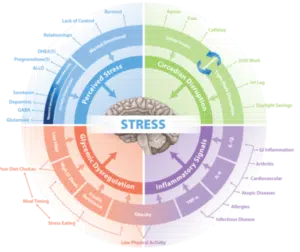
Improving resistance, resilience, and recovery from COVID-19 through personalised nutrition and lifestyle interventions
A holistic element of improving resistance, resilience, and recovery from long Covid through personalised nutrition and lifestyle interventions is described here highlighting five specific focus

